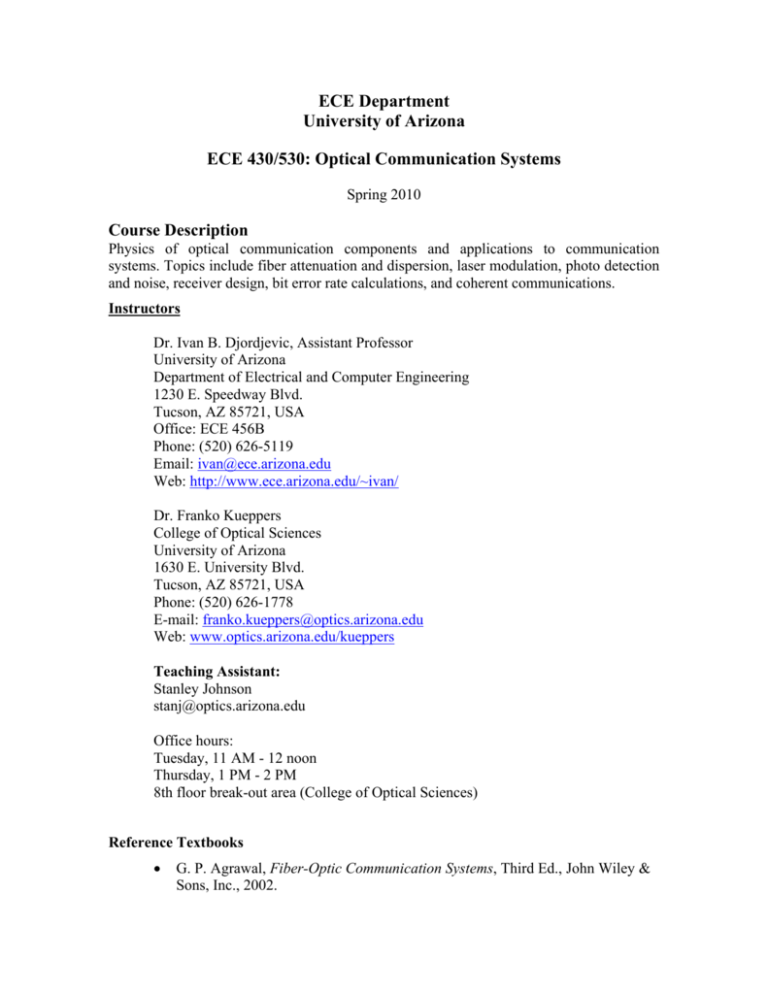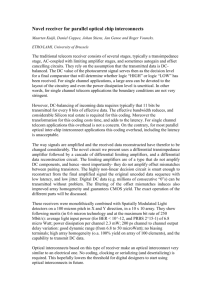ECE Department University of Arizona ECE 430/530: Optical
advertisement

ECE Department University of Arizona ECE 430/530: Optical Communication Systems Spring 2010 Course Description Physics of optical communication components and applications to communication systems. Topics include fiber attenuation and dispersion, laser modulation, photo detection and noise, receiver design, bit error rate calculations, and coherent communications. Instructors Dr. Ivan B. Djordjevic, Assistant Professor University of Arizona Department of Electrical and Computer Engineering 1230 E. Speedway Blvd. Tucson, AZ 85721, USA Office: ECE 456B Phone: (520) 626-5119 Email: ivan@ece.arizona.edu Web: http://www.ece.arizona.edu/~ivan/ Dr. Franko Kueppers College of Optical Sciences University of Arizona 1630 E. University Blvd. Tucson, AZ 85721, USA Phone: (520) 626-1778 E-mail: franko.kueppers@optics.arizona.edu Web: www.optics.arizona.edu/kueppers Teaching Assistant: Stanley Johnson stanj@optics.arizona.edu Office hours: Tuesday, 11 AM - 12 noon Thursday, 1 PM - 2 PM 8th floor break-out area (College of Optical Sciences) Reference Textbooks • G. P. Agrawal, Fiber-Optic Communication Systems, Third Ed., John Wiley & Sons, Inc., 2002. • R. L. Freeman, Fiber-Optic Systems for Telecommunications, John Wiley & Sons, Inc., 2002. Office Hours 1:00 PM – 2:00 PM, Monday and Wednesday Prerequisites SIE 305, ECE 340, ECE 352, ECE 381; Concurrent registration: ECE 431. Homeworks and projects “Homework assignments” will be given in the form of “exercises,” i.e. problems with example solutions provided. They do not have to be turned in for grading. Nevertheless, any questions regarding the exercises will be discussed individually or in class. Two projects will be carried out in small groups (3-4 students): (i) a literature research project and (ii) a system design project. Project progress has to be reported continuously over the course of the semester; final presentations have to be given. Graduate students will have an additional task to solve in their system design project. Exams Final exam will be given at the end of the semester. Grading Homework Literature Research Project System Design Project Final Exam 0% 25% 35% 40% Tentative Course Outline • Introduction • Optical Fibers • - Geometrical-Optics Description - Wave Propagation - Chromatic Dispersion - Polarization Mode Dispersion - Dispersion-Induced Limitations - Fiber Losses - Nonlinear Optical Effects Optical Transmitters • • • • - Light-Emitting Diodes - Semiconductor Lasers - Control of Longitudinal Modes - Laser Characteristics - Transmitter Design Optical Receivers - Common Photodetectors - Receiver Design - Receiver Noise - Receiver Sensitivity - Sensitivity Degradation - Receiver Performance Optical Amplifiers - Semiconductor Optical Amplifiers - Raman Amplifiers - Erbium-Doped Fiber Amplifiers - Parametric Amplifiers - System Applications Multichannel Systems - WDM Lightwave Systems - WDM Components - WDM System Performance Issues - Time-Division Multiplexing - Subcarrier Multiplexing - Orthogonal Frequency Division Multiplexing (OFDM) - Code-Division Multiplexing Coherent Lightwave Systems - Homodyne and heterodyne detection - Optical hybrids and balanced receivers - Modulation formats: ASK, FSK, PSK, QAM - Demodulation schemes • • - Polarization diversity - Polarization multiplexing - Coherent OFDM systems - Bi-error rates and receiver sensitivity - Sensitivity degradation - System performance Optical Transmission Enabling Technologies - Dispersion Management - Modulation Formats - Nonlinearity Management - Wavelength Conversion - Optical 3R - Forward Error Correction Optical Networks - LANs - MANs - Long-Haul Networks - Design Guidelines Study Groups: Working in study groups can be beneficial if everyone participates. Therefore, while working in study groups is allowed and even encouraged, all work submitted for a grade must be your own. When this rule is violated, the guilty student will receive a grade of zero on the offending item. Cheating will not be tolerated.






